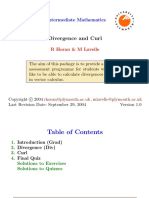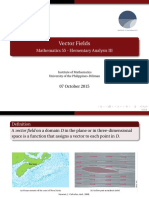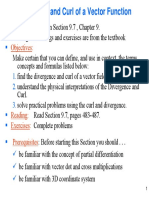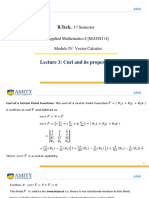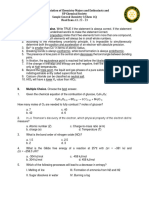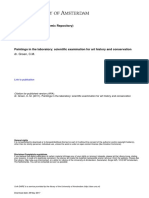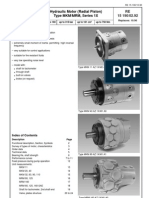Curl Matlab
Uploaded by
Nikhil ChaudhariCurl Matlab
Uploaded by
Nikhil ChaudhariSpring 2004 Math 253/501503
14 Vector Calculus
14.5 Curl and Divergence
Thu, 08/Apr c 2004, Art Belmonte
Summary
Let F(x, y, z) = [P, Q, R] be a vector eld and f (x, y, z) be a
scalar eld.
Denitions
The vector differential operator del is
x
,
y
,
.
The gradient of f is
f =
f
x
, f
y
, f
z
.
The curl of F is curl F =
F =
i j k
z
P Q R
R
y
Q
z
, P
z
R
x
, Q
x
P
y
.
The divergence of F is div F =
F = P
x
+ Q
y
+ R
z
.
The laplacian of f is
2
f =
f = f
xx
+ f
yy
+ f
zz
.
The laplacian of F is
2
P,
2
Q,
2
R
.
Theorems
The curl of a gradient vector eld is the zero vector. That is,
curl
= 0 = [0, 0, 0].
If F is a vector eld dened on R
3
such that curl F = 0 (the
zero vector [0, 0, 0]), then F is conservative; i.e., F =
f
for some scalar potential function f .
If F is a vector eld on R
3
whose components have
continuous second-order partial derivatives, then
div curl F = 0, the scalar zero.
Hand Examples
905/2
Find the curl & divergence of the vector eld F =
x
2
y, yz
2
, x
2
z
.
Solution
The curl of F is curl F =
F or
i j k
z
x
2
y yz
2
x
2
z
2yz, 2xz, x
2
.
The divergence of F is div F =
F or
x
,
y
,
x
2
y, yz
2
, x
2
z
= 2xy +z
2
+ x
2
.
905/18
Is the vector eld F = [xz, xy, yz] conservative? If so, nd a
scalar potential function f for F.
Solution
Assume that F, which is dened on R
3
, is conservative. Then it is
the gradient of some scalar eld f . By the rst theorem, we have
0 = curl
f = curl F. But the curl of F is curl F =
F or
i j k
z
xz xy yz
= [z, x, y] = [0, 0, 0] .
We thus have a contradiction. Accordingly, the vector eld F is
not conservative.
MATLAB Examples
905/6
Find the curl and divergence of F =
sin x, cos x, z
2
.
Solution
In MATLAB you may use the Curl and div commands I wrote.
(Cooper already had a different routine called curl.) There are
also curl and div commands available on your TI-89 on the
FVMD menu (Functions and Matrix & Vector Derivatives).
%
% Stewart 905/6
%
syms x y z
F = [sin(x) cos(x) z2];
curl F = Curl(F); pretty(curl F)
[0 0 -sin(x)]
div F = div(F); pretty(div F)
cos(x) + 2 z
%
echo off; diary off
1
905/16
Is the vector eld F =
x, e
y
sin z, e
y
cos z
conservative? If so,
nd a scalar potential function f for F.
Solution
We see that curl F = 0 on R
3
. So F is conservative by the second
theorem in the Summary. We then use the pot command to yield
the desired potential function f .
%
% Stewart 905/16
%
syms x y z
v = [x y z];
F = [x exp(y)*sin(z) exp(y)*cos(z)];
curl F = Curl(F); pretty(curl F)
[0 0 0]
f = pot(F,v); pretty(f)
2
1/2 x + exp(y) sin(z)
%
echo off; diary off
906/38
Given the position vector eld r = [x, y, z] and spherical radius
variable =
x
2
+ y
2
+z
2
, verify the identity
3
= 12,
where
2
is the laplacian.
Solution
We simply show that
3
12 = 0. Done!
%
% Stewart 906/38
%
syms x y z
v = [x y z];
r = len(v)
r =
(x2+y2+z2)(1/2)
f = r3;
% Left - Right = 0
lmrez = simple(laplacian(f) - 12*r)
lmrez =
0
%
echo off; diary off
2
You might also like
- Divergence and Curl: Intermediate MathematicsNo ratings yetDivergence and Curl: Intermediate Mathematics29 pages
- Divergence and Curl: Intermediate MathematicsNo ratings yetDivergence and Curl: Intermediate Mathematics29 pages
- MAT-250 - Chapter 15 (Excluding 15.8. It Comes Later)No ratings yetMAT-250 - Chapter 15 (Excluding 15.8. It Comes Later)53 pages
- W e Are Getting Less and Less Rigorous !No ratings yetW e Are Getting Less and Less Rigorous !5 pages
- 4.06 Gradient Divergence Curl and LaplacianNo ratings yet4.06 Gradient Divergence Curl and Laplacian8 pages
- Gradient, Divergence and Curl: Eddie WilsonNo ratings yetGradient, Divergence and Curl: Eddie Wilson22 pages
- Vector Analysis 1: Vector Fields: Thomas Banchoff and Associates June 17, 2003No ratings yetVector Analysis 1: Vector Fields: Thomas Banchoff and Associates June 17, 20039 pages
- Math 23 Lecture 3.5 Vector Fields, Curl, and DivergenceNo ratings yetMath 23 Lecture 3.5 Vector Fields, Curl, and Divergence18 pages
- Divergence and Curl of A Vector Function: ObjectivesNo ratings yetDivergence and Curl of A Vector Function: Objectives13 pages
- B.Sc. 1st Year (Semester-II) : Prepared By: Department of Physics, Govt. Degree College Boys PulwamaNo ratings yetB.Sc. 1st Year (Semester-II) : Prepared By: Department of Physics, Govt. Degree College Boys Pulwama31 pages
- Chapter 3 - Integration in Vector FieldsNo ratings yetChapter 3 - Integration in Vector Fields56 pages
- 3.vector Differentiation - Summer 23-24No ratings yet3.vector Differentiation - Summer 23-2430 pages
- Production Q A 2013 S K Mondal Mobile Version67% (3)Production Q A 2013 S K Mondal Mobile Version557 pages
- Investigation of The Use of The Binding MediumNo ratings yetInvestigation of The Use of The Binding Medium24 pages
- King Fahd University of Petroleum & MineralsNo ratings yetKing Fahd University of Petroleum & Minerals15 pages
- Evaporation: Heat Transfer Coefficients and Single Effect EvaporatorsNo ratings yetEvaporation: Heat Transfer Coefficients and Single Effect Evaporators26 pages
- Chapter 1: FLOW IN SOIL: Cohesion Force Adhesion ForceNo ratings yetChapter 1: FLOW IN SOIL: Cohesion Force Adhesion Force7 pages
- Rotational Motion by Kota Practice Test Iit JeeNo ratings yetRotational Motion by Kota Practice Test Iit Jee6 pages
